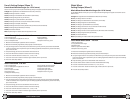
www.oster.com
14
www.oster.com
15
3 When the delay timer is set where you want it, make sure to press the “Start/Stop”
button. The colon “:” will fl ash and your bread will be ready when you planned.
Important: When using the delay timer during times of hot weather, you may wish to
reduce the liquid in your recipe by 1 or 2 tablespoons. This is to prevent the dough from
rising too much. You may also reduce the salt by 1/8 or 1/4 teaspoons and try cutting the
amount of sugar you use by 1/4 teaspoon at a time.
Tips and Hints
Experienced cooks consider bread making to be as much of an art as a science. Keep in
mind that some recipes may require a little experimentation before they are exactly the
way you want them. Just don’t give up. Still, there are special hints to ensuring quality
bread almost every time.
Use Exact Measurements
We’ve already mentioned how important it is to use exact measurements when baking
bread, but it should be said again. Level off all dry ingredients and make sure that all liquid
ingredients are measured in a glass cup with the markings clearly labeled on the side.
Use Fresh Ingredients
You should always use fresh ingredients. The reasons are:
• Flour - If you have stored your fl our for a long time, it may have become wet from
absorbing moisture, or dry, depending on the area of the country in which you live.
We recommend using fresh bread fl our.
• Yeast - Fresh yeast is probably the most important ingredient in baking bread. If the yeast
is not fresh, your bread may not rise. It is better to buy new yeast than to take a chance on
yeast that has been stored for a long time.
You can test the freshness of your yeast. Simply fi ll a cup with warm water, then add and stir
in 2 teaspoons of sugar. Sprinkle a few teaspoons of yeast on the surface of the water and
wait. After 15 minutes, the yeast should foam and there should be distinct odor. If neither
reaction happens, the yeast is old and should be thrown away.
Add Ingredients in the Correct Order
Read all recipes from top to bottom, and remember:
- FIRST, liquid ingredients
- SECOND, dry ingredients
- LAST, yeast
For Baking at High Altitudes
If you live above 3000 feet, you probably already know how to adjust other recipes like
cakes and muffi ns.
Higher altitudes tend to:
• Make dough rise faster
• Make fl our drier
To compensate for high altitude baking, we recommend the following:
If the dough is too dry
• Increase the amount of water to the recipe, sometimes as much as 2–4 tablespoons per cup.
If the bread rises too high
• Reduce the amount of yeast. For each teaspoon of yeast, try reducing the yeast by
1/8 to 1/4 teaspoon.
• Reduce the amount of sugar. For each tablespoon of sugar, reduce the amount by
1 to 2 teaspoons.
Measurement Equivalency Chart
The following chart will help you convert measurements used in the recipes.
For example: 1/2 tablespoon = 1–1/2 teaspoons
Fluid Ounce(s) Cup(s) Tablespoon(s) Teaspoon(s)
8 = 1 = 16 = 48
7 = 7/8 = 14 = 42
6 = 3/4 = 12 = 36
5 = 5/8 = 10 = 30
4 = 1/2 = 8 = 24
3 = 3/8 = 6 = 18
2 = 1/4 = 4 = 12
1 = 1/8 = 2 = 6
= = 1 = 3
1/2 = 1 1/2


















